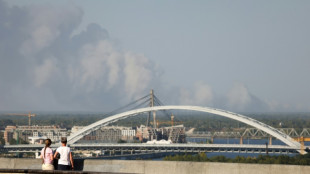
-
 Mbappe on target as Real Madrid cruise to Leganes win
Mbappe on target as Real Madrid cruise to Leganes win
-
Sampaoli beaten on Rennes debut as fans disrupt Nantes loss

-
 Israel records 250 launches from Lebanon as Hezbollah targets Tel Aviv, south
Israel records 250 launches from Lebanon as Hezbollah targets Tel Aviv, south
-
Australia coach Schmidt still positive about Lions after Scotland loss

-
 Man Utd 'confused' and 'afraid' as Ipswich hold Amorim to debut draw
Man Utd 'confused' and 'afraid' as Ipswich hold Amorim to debut draw
-
Sinner completes year to remember as Italy retain Davis Cup

-
 Climate finance's 'new era' shows new political realities
Climate finance's 'new era' shows new political realities
-
Lukaku keeps Napoli top of Serie A with Roma winner

-
 Man Utd held by Ipswich in Amorim's first match in charge
Man Utd held by Ipswich in Amorim's first match in charge
-
'Gladiator II', 'Wicked' battle for N. American box office honors

-
 England thrash Japan 59-14 to snap five-match losing streak
England thrash Japan 59-14 to snap five-match losing streak
-
S.Africa's Breyten Breytenbach, writer and anti-apartheid activist

-
 Concern as climate talks stalls on fossil fuels pledge
Concern as climate talks stalls on fossil fuels pledge
-
Breyten Breytenbach, writer who challenged apartheid, dies at 85

-
 Tuipulotu try helps Scotland end Australia's bid for Grand Slam
Tuipulotu try helps Scotland end Australia's bid for Grand Slam
-
Truce called after 82 killed in Pakistan sectarian clashes

-
 Salah wants Liverpool to pile on misery for Man City after sinking Saints
Salah wants Liverpool to pile on misery for Man City after sinking Saints
-
Berrettini takes Italy to brink of Davis Cup defence

-
 Lille condemn Sampaoli to defeat on Rennes debut
Lille condemn Sampaoli to defeat on Rennes debut
-
Basel backs splashing the bucks to host Eurovision

-
 Leicester sack manager Steve Cooper
Leicester sack manager Steve Cooper
-
IPL auction records tumble as Pant, Iyer break $3 mn mark

-
 Salah sends Liverpool eight points clear after Southampton scare
Salah sends Liverpool eight points clear after Southampton scare
-
Key Trump pick calls for end to escalation in Ukraine

-
 Tuipulotu try helps Scotland end Australia's bid for a Grand Slam
Tuipulotu try helps Scotland end Australia's bid for a Grand Slam
-
Davis Cup organisers hit back at critics of Nadal retirement ceremony

-
 Noel in a 'league of his own' as he wins Gurgl slalom
Noel in a 'league of his own' as he wins Gurgl slalom
-
A dip or deeper decline? Guardiola seeks response to Man City slump

-
 Germany goes nuts for viral pistachio chocolate
Germany goes nuts for viral pistachio chocolate
-
EU urges immediate halt to Israel-Hezbollah war

-
 Far right targets breakthrough in Romania presidential vote
Far right targets breakthrough in Romania presidential vote
-
Basel votes to stump up bucks to host Eurovision

-
 Ukraine shows fragments of new Russian missile after 'Oreshnik' strike
Ukraine shows fragments of new Russian missile after 'Oreshnik' strike
-
IPL auction records tumble as Pant and Iyer snapped up

-
 Six face trial in Paris for blackmailing Paul Pogba
Six face trial in Paris for blackmailing Paul Pogba
-
Olympic champion An wins China crown in style

-
 It's party time for Las Vegas victor Russell on 'dream weekend'
It's party time for Las Vegas victor Russell on 'dream weekend'
-
Former Masters champion Reed seals dominant Hong Kong Open win

-
 Norris applauds 'deserved' champion Verstappen
Norris applauds 'deserved' champion Verstappen
-
Jaiswal and Kohli slam centuries as Australia stare at defeat

-
 Kohli blasts century as India declare against Australia
Kohli blasts century as India declare against Australia
-
Verstappen 'never thought' he'd win four world titles

-
 Former Masters champion Reed wins Hong Kong Open
Former Masters champion Reed wins Hong Kong Open
-
Awesome foursomes: Formula One's exclusive club of four-time world champions

-
 Smylie beats 'idol' Cameron Smith to win Australian PGA Championship
Smylie beats 'idol' Cameron Smith to win Australian PGA Championship
-
Five key races in Max Verstappen's 2024 title season

-
 Max Verstappen: Young, gifted and single-minded four-time F1 champion
Max Verstappen: Young, gifted and single-minded four-time F1 champion
-
'Star is born': From homeless to Test hero for India's Jaiswal

-
 Verstappen wins fourth consecutive Formula One world title
Verstappen wins fourth consecutive Formula One world title
-
Survivors, sniffing dogs join anti-mine march at Cambodia's Angkor Wat


Stressed out: how to measure dangerous heat
In the hottest year on record, with scorching conditions claiming lives from India to Mexico and Greece sweltering in its earliest-ever heatwave, experts are sounding the alarm over heat stress.
The condition kills more people than hurricanes, floods or any other climate-related extreme, but what is heat stress exactly, and how is it measured?
- 'Silent killer' -
Heat stress occurs when the body's natural cooling systems are overwhelmed, causing symptoms ranging from dizziness and headaches to organ failure and death.
It is brought on by prolonged exposure to heat and other environmental factors that work together to undermine the body's internal thermostat and its ability to regulate temperature.
"Heat is a silent killer, because symptoms are not so easily evident. And when these underlying conditions are present, the consequences can be very bad, and even catastrophic," said Alejandro Saez Reale of the World Meteorological Organization (WMO).
Infants, the elderly, people with health problems and outdoor workers are particularly vulnerable. City dwellers surrounded by concrete, brick and other heat-absorbing surfaces also face an elevated risk.
The WMO estimates that heat kills around half a million people a year but says the true toll is not known, and could be 30 times higher than is currently recorded.
As climate change makes heatwaves longer, stronger and more frequent, people across the planet will be increasingly exposed to conditions that test the limits of human endurance.
- More than a maximum -
Temperature might be the most widely used and easily understood weather reading, but headline-catching "maximum highs" do not fully tell how heat might affect the human body.
For example, the same temperature can feel very different in one place versus another: 35 degrees Celsius (95 Fahrenheit) feels much different in the dry heat of the desert versus the humid climes of a jungle.
To build a more complete picture, scientists consider a host of factors including temperature but also humidity, wind speed, clothing, direct sunshine, and even the amounts of concrete or greenery in the area.
All these play a big role in how the body perceives, and most importantly responds to, extreme heat.
There are many ways to measure heat stress, some of which are decades old, but all try to boil down different environmental readings into a single number or graph.
- 'Feels like' -
One of the oldest methods is known as wet-bulb temperature, a useful gauge in situations where the thermometer reading may not seem too extreme but when combined with humidity becomes unbearable, even lethal.
Just six hours exposed to 35 degrees Celsius with 100 percent humidity is enough to kill a healthy person, scientists said in 2023. Above this limit, sweat cannot evaporate off the skin, and the body overheats and expires.
Copernicus, the EU's climate monitor, uses the Universal Thermal Climate Index (UTCI), which considers temperature and humidity but also wind, sunshine and radiated heat to rank heat stress levels from moderate to extreme.
Extreme heat stress, as judged by this index, is a "feels like" temperature of 46 Celsius and above, at which point it is necessary to take action to avoid health risks.
The Heat Index, used by the US National Weather Service, offers an "apparent temperature" based on heat and humidity in the shade, and a colour-coded graph denoting the likelihood of illness from exposure.
Canada has developed the Humidex rating, which combines heat and humidity into one number to reflect the "perceived temperature" and presents the associated risk in a four-step "guide to summer comfort" chart.
- Limitations -
Other examples of "thermal stress" indices include the Tropical Summer Index, Predicted Heat Strain and the mean radiant temperature.
They are not without limitations, and heatwave expert John Nairn said some measures worked better in some climates than others.
"It's not the same all around the world, about the way you approach it," Nairn told AFP.
The UTCI, for example, is excellent at reading heat stress in Germany, where it was first developed, but "a very poor measure" in global south countries, he said.
"It saturates and over-measures far too much. And it would over-alert for those communities who are chronically exposed to heat," said Nairn, who has advised governments and the WMO on heatwave policy.
These locations might get better heat stress readings using wet-bulb temperature, he said.
These indices also do not consider the impact of heat beyond health, he said, even though a heatwave could strand trains or overload air-conditioners.
"If your heat challenge is such that it gets to a level where your infrastructure is not going to operate, and it starts failing, that will have a return on humans no longer being protected," Nairn said.
L.Dubois--BTB



